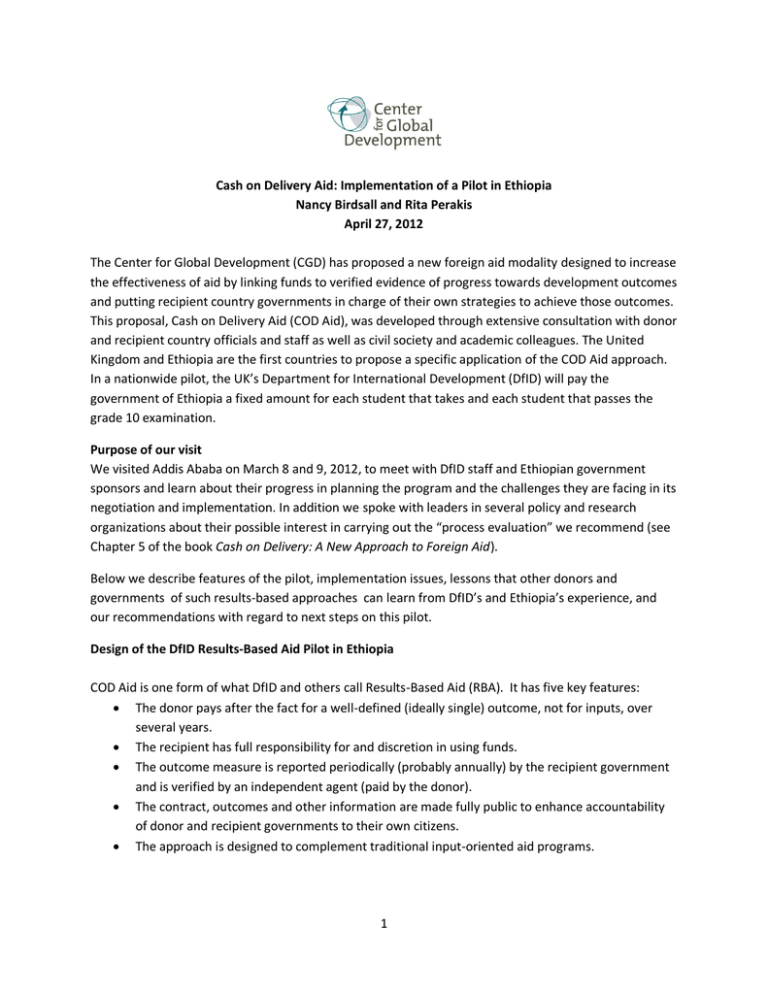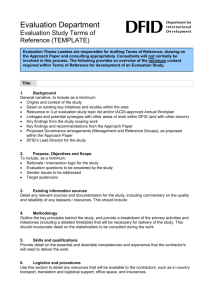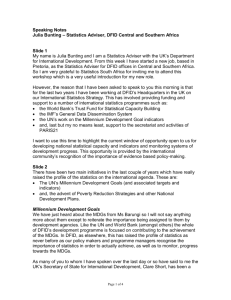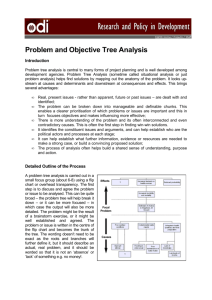Cash on Delivery Aid: Implementation of a Pilot in Ethiopia
advertisement

Cash on Delivery Aid: Implementation of a Pilot in Ethiopia Nancy Birdsall and Rita Perakis April 27, 2012 The Center for Global Development (CGD) has proposed a new foreign aid modality designed to increase the effectiveness of aid by linking funds to verified evidence of progress towards development outcomes and putting recipient country governments in charge of their own strategies to achieve those outcomes. This proposal, Cash on Delivery Aid (COD Aid), was developed through extensive consultation with donor and recipient country officials and staff as well as civil society and academic colleagues. The United Kingdom and Ethiopia are the first countries to propose a specific application of the COD Aid approach. In a nationwide pilot, the UK’s Department for International Development (DfID) will pay the government of Ethiopia a fixed amount for each student that takes and each student that passes the grade 10 examination. Purpose of our visit We visited Addis Ababa on March 8 and 9, 2012, to meet with DfID staff and Ethiopian government sponsors and learn about their progress in planning the program and the challenges they are facing in its negotiation and implementation. In addition we spoke with leaders in several policy and research organizations about their possible interest in carrying out the “process evaluation” we recommend (see Chapter 5 of the book Cash on Delivery: A New Approach to Foreign Aid). Below we describe features of the pilot, implementation issues, lessons that other donors and governments of such results-based approaches can learn from DfID’s and Ethiopia’s experience, and our recommendations with regard to next steps on this pilot. Design of the DfID Results-Based Aid Pilot in Ethiopia COD Aid is one form of what DfID and others call Results-Based Aid (RBA). It has five key features: The donor pays after the fact for a well-defined (ideally single) outcome, not for inputs, over several years. The recipient has full responsibility for and discretion in using funds. The outcome measure is reported periodically (probably annually) by the recipient government and is verified by an independent agent (paid by the donor). The contract, outcomes and other information are made fully public to enhance accountability of donor and recipient governments to their own citizens. The approach is designed to complement traditional input-oriented aid programs. 1 DfID and the Government of Ethiopia are the first to design and negotiate an aid program based on the Cash on Delivery Aid model. DfID will make grant payments to the education ministry for the increase in the number of students above a baseline that sits for or passes the national grade 10 exam.1 There will be additional payments for students in emerging regions, and for girls compared to boys. The payment structure is outlined in Figure 1. A maximum of £10 million will be disbursed each year from 2012 to 2014. Funds will be additional to existing support in the education sector, which DfID provides largely through the Protection of Basic Services (PBS) program and the General Education Quality Improvement Program (GEQIP).2 Figure 1: DfID RBA education pilot payment structure In Emerging Regions3 DfID pays … … for each additional student sitting the exam plus an additional … for each of these students who pass the exam Boys £75 £75 Girls £100 £100 In Non-emerging Regions DfID pays … … for each additional student sitting the exam plus an additional … for each of these students who pass the exam Boys £50 £50 Girls £85 £85 The Government of Ethiopia maintains robust education examination and information management systems, upon which its reports of grade 10 examination results will be based. DfID has contracted an 1 The choice to pay for students that sit for the exam, regardless of whether they pass, is in part based on CGD’s proposal that donors should commit to pay for additional “assessed completers”, defined as students that make it to the final year of school and take a standardized competency test. This minimizes incentives to misreport progress, as opposed to paying for the achievement of certain test scores. In theory, making test scores and terms of the contract between the donor recipient public and easily accessible will create public pressure for improved test scores over time. DfID and the Government of Ethiopia have introduced a payment for passers of the exam, in addition to sitters, in the short term as a quality indicator. 2 PBS is a multi-donor program that aims to improve quality and access to services delivered by local governments. The second phase of the project, which covers the period 2009 to 2013, will involve approximately $4 billion transferred to regions in the form of block grants. About half of PBS funds are for the education sector. GEQIP is a $400 million multi-donor program to support the education sector from 2009-2013. 3 Ethiopia’s poorest regions, known as the emerging regions are Afar, Somali, Benishangul, Gomuz and Gambella. 2 independent agency to verify the results that the government reports. The agency will analyze reported data on enrollment, retention, and pass rates from Ethiopia’s National Agency for Educational Assessment and Examinations (NAEAE), and will compare the data by region and gender with that of previous years to check for consistency and identify any possible changes in trends. It will also visit a sample of schools in each region to compare national reports with the school’s reports and verify that the nationally reported results are accurate. Based on current discussions between DfID and Ethiopia, the exam data from 2010/11 would provide an initial baseline and the baseline would be adjusted annually with performance for one year becoming the baseline for the next year’s payments. Once results are verified, DfID will disburse outcome payments for additional students above the baseline that sit for the exam and a further payment for the additional students who pass the exam. The Ministry of Education will have full discretion on how funds received are allocated. Although DfID will not impose any rules on how funds should be used, staff are responding to requests from the government for technical advice on options for allocating funds to regions and secondary schools. Issues and recommendations Overall Design The design of the DfID RBA pilot is excellent. DfID has overcome typical challenges for donors by moving forward with a program that is truly results-focused, which rewards incremental progress, and in which the donor agency is hands-off, giving the government control in deciding how outcomes will be achieved and how subsequent payments will be used. DfID has designed the pilot in close consultation with the education ministry of Ethiopia, which has engaged the finance ministry and regional governments throughout the design phase. The “pure” COD Aid model proposed by CGD involves payments to the highest level of central government, such as through a finance ministry, to create incentives for different ministries and levels to work together to achieve the desired results, including through steps that might be taken by other parts of government not just within the education sector itself. Though in this pilot, the key interlocutor for the government is the Ministry of Education, we were told that the Ministry of Finance has taken greater interest in the planning and design of the project than is usual, and that this has been useful from the point of view of education officials. The approach in Ethiopia provides a good example of the complementarity of RBA to other aid financing. The £30 million DfID has allocated to this project over a three-year period is not large relative to the almost $1 billion a year Ethiopia receives from DfID and other donors for health and education services. Recurrent costs, such as the funding of textbooks and salaries, will continue to be financed through the large donor-funded PBS and GEQIP programs. The RBA agreement, despite involving relatively little funding, has already drawn significant attention to tracking progress on secondary schooling and its quality. The RBA payment will also be an incentive to use existing donor funds and the government’s 3 own resources more efficiently in improving secondary education and extending it to hard-to-reach areas and to girls more quickly. The agreement between DfID and the government of Ethiopia is structured to pay a maximum of £10 million for each year between 2012 and 2014. Although this structure is typically necessary to fit donors’ accounting requirements, we recommend that DfID revisit the possibility of setting up the pilot as a three-year £30 million Memorandum of Understanding (MOU), with annual disbursements and no annual maximum. Such a change would assure that the government has an incentive to make progress as quickly as possible, and not game the program by holding back in a given year so as to facilitate reaching a full payout in the following year. It would also give the government the assurance that if it took initiatives in the first year that yield benefits only in later years that it could reap the full benefits of those investments. Measurement and Verification In the COD Aid proposal, the government is responsible for measuring and reporting annual outcomes, and the donor is responsible for contracting an agent to independently verify the government’s progress reports. In this RBA pilot for Ethiopia, DfID has put considerable resources into assuring itself that the government has the capacity to report on the number of students that take and pass the test and that the test itself is an adequate measure of what students are learning. An outside consultant’s report is impressively thorough on this point. Measurement and verification of the outcome (taking and passing a test) are clearly a challenge, and in the case of this pilot, the donor has been appropriately careful. The grade 10 exam, upon which outcome payments are made, marks the end of the first cycle of secondary education and is used to determine whether students will go on to a vocational training or university-preparatory track for grades 11 and 12. There are several issues: 1) Will incentive payments create pressures to cheat on exams? DfID will be disbursing funds to the federal government and the temptation to inflate test scores will be counterbalanced by the process of independent verification. However, the Ministry of Education may decide to transfer funds it receives to regions or districts responsible for management and administration of education, and might encourage districts to transfers funds to schools on the basis of specific district and/or school-specific results. The consultant report on testing indicates that currently the test is well-implemented and robust; cheating is not a problem. At the moment, no decision has been made about distribution of the performance funds by the central Ministry of Education – whether to distribute them at all, and if so, whether to regions, districts or even schools on the basis of overall performance at each level. To the extent that at some point there were such a distribution it would increase the stakes and thus the incentives for cheating – and the more so the lower the level at which performance is rewarded.4 (This could also be the case when as we 4 Cheating at the school and the school district level in the United States, for example, has been a problem, especially since the passage of the federal No Child Left Behind legislation. 4 advise below, there is more attention to reporting to the public and to school officials the results of the annual tests.) We therefore recommend that DfID include in the TOR for the independent verification consultant firm re-testing of a small sample of children in a small sample of schools to verify that cheating has not been a problem. 2) It is not clear the extent to which the grade 10 examination is “equivalent” (different questions but same overall level of difficulty) from year to year. That makes it difficult to assess the extent to which there are improvements over time in student learning, the real outcome of interest. This is typical of tests in Africa and elsewhere in the developing world that have been used primarily to screen among students in any given year for those most able and ready to proceed to higher levels of what kind of schooling, as opposed to being used as a measure of progress of the school system in increasing overall student learning. This pilot provides an ideal setting for the government of Ethiopia to set in place a process for establishing a test that meets a global standard in terms of equivalence; we recommend that the Ministry of Education in the course of the three-year pilot take steps to institute such a process, thus taking leadership in Africa in clarifying the broad objectives of testing in general. As the secondary education pilot proceeds, we hope that the Ministry of Education will also take steps to adapt and extend the USAIDfunded National Learning Assessment (which has been administered to grade 4 and grade 8 students in a sample of schools every three to four years since 2000) to 10th graders, making it an annual exam of all students nationwide. Eventually the Ministry with the support of DfID and other donors might consider integrating this type of learning assessment into the national examination system. Transparency and Accountability The structure of a COD Aid agreement, compared to a traditional aid project, allows the government to increase accountability to its own citizens. The government’s main responsibility is achieving outcomes, not tracking inputs from the donor, so citizens can hold their government accountable for these outcomes. However, for citizens to hold the government accountable, they need information about the agreement and its implementation. In this regard, we recommend that DfID and the government of Ethiopia agree to make three key pieces of information available to the public: the actual content of the RBA agreement; the annual results of the grade 10 examination at least at the national level, and ideally at the region or district level; and the amount of the RBA payment to the national government. DfID and the education ministry have not yet clarified how these aspects of the agreement will be disseminated. Test results are available at schools and the Ministry of Education website but DfID and the government will have to decide how to make these results more easily accessible. They will also have to decide how to disseminate the RBA agreement, to report the national figures on additional 10 th graders who sit for the exam and who pass relative to the baseline, to publish the verification reports, to deal with any possible discrepancies between the government’s reports and the verification reports, and to report the disbursements. 5 We suggest that the government begin with a press release that can be disseminated to communities so that they know that the pilot is in progress and there is a potential monetary bonus for improved retention and performance at grade 10. The Parent Teacher Associations, which are active in Ethiopia, may be another vehicle for disseminating the terms and progress of the RBA agreement. Since the Ministry of Education has approached DfID to discuss how results will be published and disseminated, we recommend that DfID support the Ministry in establishing a more formal process. Evaluation of the RBA modality -- additional to evaluation of education strategies DfID has commissioned work on design of an evaluation of the program which will rigorously assess the impact of the strategies that the Ethiopian government chooses to employ in order to improve secondary school performance. While this evaluation work is essential for providing guidance to Ethiopia and other similar countries regarding the effectiveness of education strategies, the study is not designed to assess whether the modality of RBA is itself an improvement over other aid modalities, with respect for example to bringing greater interaction across ministries and levels of government on a shared goal, lower transactions costs with the sponsoring donor and with other donors, and so on. Because the RBA mechanism is itself a major innovation, we recommend that DfID and the government exploit this important opportunity to do support such an assessment. A first step would be to ask us or a different independent group to develop terms of reference for the kinds of analyses that might be done, over what period, ideally led by someone in Ethiopia familiar with local institutions and relationships. Chapter 5 of Cash on Delivery Aid: A New Approach to Foreign Aid distinguishes these two kinds of evaluation. The effectiveness of sectoral strategies to improve outcomes, e.g. actions at the secondary school level, is described as level two research; while the effectiveness of the aid modality (RBA) relative to traditional modalities is described as level one research (see pp. 76-79). While these are interrelated, the evaluation of the RBA modality requires collecting different kinds of information with different research methods. In particular, it requires researchers with experience in institutional, political and social research who can follow the process of decision-making in government and public sector responses to the RBA agreement and make judgments regarding how the RBA pilot is functioning compared to other aid modalities. Conclusion In negotiating this RBA agreement, DfID and the Ethiopian government are establishing a new standard for relationships between funders and recipients – one which focuses attention explicitly on outcomes and which gives real meaning to the concept of “country ownership.” The agreement addresses key features of COD Aid by: Paying for outcomes not inputs (students sitting for the exam and passing the exam); giving the Ethiopian government primary responsibility for choosing how to make progress; establishing a process to independently verify results; and making the program complementary to existing aid and domestic resources. The terms of the agreement in terms of the fifth feature of COD Aid – transparency – are still being worked out. 6 As DfID and Ethiopia work out the details of their RBA agreement, we hope they will consider the benefits of the following recommendations: If possible, the annual limits on payments should be lifted and the possibility of rolling over funding to later years should be included. Continued attention should be given to ensuring that the secondary exams are good measures of learning, that they are comparable over time, and that their integrity is maintained and improved. Explicit attention should be given in the memorandum of understanding to transparency, including publishing the full content of the MOU; student test results; discrepancies detected in verification; and disbursements. The performance of the RBA agreement relative to traditional aid should be evaluated. Consideration should be given to expanding the pilot to include initial steps in moving to nationwide testing at the primary school level. 7 Individuals Consulted Fuad Ibrahim, State Minister for General Education Newai Gebre-ab, Economic Adviser to the Prime Minister and Executive Director, Ethiopian Development Research Institute Belay Addise, UK Department for International Development Chris Berry, UK Department for International Development Ellie Cockburn, UK Department for International Development Peter Hawkins, UK Department for International Development Andrea Ledward, UK Department for International Development Paul Walters, UK Department for International Development Gemma Wilson-Clark, UK Department for International Development Guang Chen, World Bank Robert Chase, World Bank Chorching Goh, World Bank Mohamed Ali Kamil, World Bank Alemayehu Seyoum Taffesse, International Food Policy Research Institute Alula Pankhurst, Young Lives Ethiopia 8






